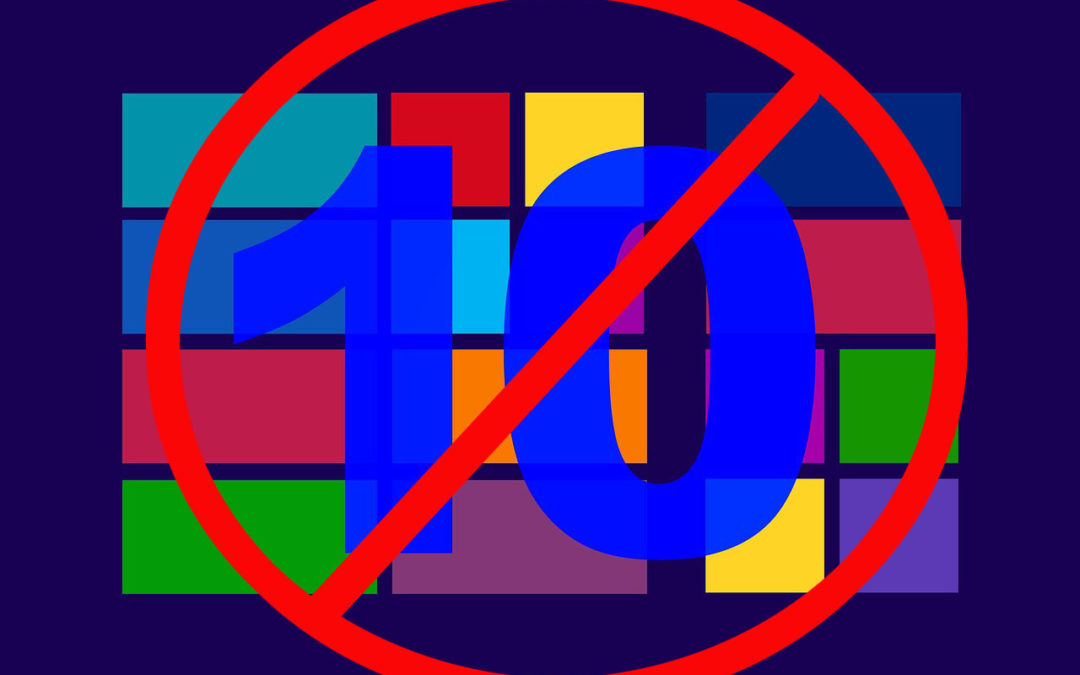UPDATE, Feb. 6, 2016 – It’s starting to look like the reason Microsoft is so determined to move users to Windows 10 is that it is essentially spyware. One independent researcher installed it on a test PC with all telemetry and feedback turned off, and found that Windows 10 was still communicating with Microsoft almost constantly. Over 8 hours, the machine made nearly 4,000 connections with over 50 servers. Not only is the sheer volume mind-boggling, what on Earth are they monitoring? And why?
More testing is needed, and is sure to be done. We’ll keep you posted as to what is found.
UPDATE, Feb. 2, 2016 – Microsoft has gotten even more pushy about Windows 10 installation. As we predicted below, the installation upgrade has been changed from “optional” to “recommended“.
This means to avoid it from installing it altogether, you need to go to Start > Control Panel > Windows Update, and click on the “Change settings” item on the left. Under “Important Updates” make sure that “Install updates automatically (recommended)” is not chosen. The best, albeit most inconvenient, choice is “Check for updates but let me decide whether to download and install them.” If you choose “Download updates but let me choose whether to install them“, the machine will fetch all the files and hide them on the computer. And this makes it much easier for Microsoft to secretly install the new OS.
Under “Recommended updates“, click the box on “Give me recommended updates the same I way I get important updates” only if you choose to check for updates but no installation. Otherwise uncheck the box.
Given their dubious track record with Windows 10, Microsoft is likely to get even more obnoxious about this in the future. Any further developments we hear of that affect this situation will be laid out here, so bookmark this page.
More information can be found here.
Original post
Microsoft has been aggressively – very aggressively, it turns out – pushing Windows 10 updates. Continual and intrusively annoying pop-ups every time you turn the machine on and repeatedly during a session are bad enough, but finding your computer in the process of downloading the OS without permission can be a real shock.
How could this happen? Microsoft changed the update from “optional” to “recommended” for Windows 7 and 8. So if your computer is set for automatic updates, or if you ever checked the box that says “install later”, it will try to grab the installation files at the first opportunity. One way to prevent this is to turn off the automatic update feature, but as many security updates are delivered in that way, this could be risky. Setting it to notify you when updates are available is much safer, but inconvenient, and you’ll still have to note the update numbers so you don’t authorize a download accidentally.
However, you should at least change your computer’s settings so that it will not automatically download “recommended” updates in the same way it does “important” ones. See steps 6 and 7 below.
Sometimes Microsoft doesn’t seem to give you any choice. One prompt comes with two buttons: “Install now” or “Install later” with no obvious way of opting out. The proper response is to click neither but the close box in the corner.
In any case, there are good, valid reasons not to install Windows 10 as we have mentioned before. Many people, particularly older users, are not at all fond of the new smartphone-like appearance. Being new, 10’s still buggy and like all Windows upgrades, the new version is an even bigger memory hog than the previous one – the installation files come to a hefty 6GB. There are also fears of backdoors, Microsoft looking for pirated or unlicensed software (like games), and the corporation’s continual user data collection has revived long-standing suspicions that its operating systems are essentially spyware.
Ironically, you may not even need a new operating system: Microsoft says they will support 7 until 2020, and 8 until 2023. But if you don’t like Windows 10 – for instance, if it makes some programs unusable – it can be a real pain stepping backwards. Even the files once downloaded but before installation are put into a hidden folder, just to prevent you from changing your mind.
So, as with other pests, the best solution is to avoid getting infected in the first place. If you’re still being nagged to install – along with pop-ups, a tiny “get Windows 10” icon (4 white Microsoft panes in perspective) will be visible in your taskbar or in the small window that comes up when you click on it – you’re in luck: it hasn’t downloaded yet.
What you will want to do is 1) halt any download if you catch it in progress, 2) prevent your system from downloading it, and 3) make sure it stops bugging you. The method below is used by our techs – demonstrated on the very computer this is being written on.
While this technique may require repeating several times (this computer needed 3 restarts), you do not have to edit the registry as the method Microsoft outlines, which should not be contemplated, much less attempted, unless you are an expert. A small mistake there can instantly brick your machine, which shows just how much they don’t want to make it easy.
Those steps may be necessary, if you don’t want to ever be reminded again. But this will prevent downloading however, and the pop-ups nags, using only the Windows Update dialog.
Manually Stopping Windows 10 Download and Preventing Installation
- Go to the Start menu > Control Panel > Windows Update.
- In the Windows Update panel, you will see the “Update to Windows 10” nag. Click on the small link below that says “Installed Updates“.
- A list appears that shows your installation status. The updates are listed in categories but they only give the update number, not what they specifically do. Sort by date or use the search bar to look for “Update for Microsoft Windows” KB3035583 (which installs the new OS) and also KB2976978 (which checks for system compatibility).
- Select the update, then click “Uninstall” from the menu above the list.
- Now return to Windows Update and click “Show all available updates“. There you will find a listing “Upgrade to Windows 10“. Uncheck the box. Then right-click the selection and click “Hide update“. The box should grey out.
- In the Windows Update pane, click the small heading on the left that says “Change settings“. In that panel, under “Important updates” you have several options. The default is “Install updates automatically (recommended)” which will guarantee that you’ll have to go through this procedure again. The first option is “Download updates but let me choose whether to install them” – which will also likely result in having to redo this procedure.
- The remaining options are “Check for updates but let me choose whether to download and install them“, or “Never check for updates (not recommended“. Do not choose the last one, but “Check for updates but let me choose…” is the safest. However, if you prefer “Install updates automatically” or “Download updates but let me choose,” be sure to uncheck the box under “Recommended updates” that says “Give me recommended updates the same way I receive important updates.”
- You may have to reboot at this point and then go through at least this step again (possibly a number of times). If you ever decide you do want Windows 10, you can by clicking “Restore hidden updates” and proceed from there.
That should do it. If it worked, you should no longer see the annoying “Update to Windows 10” notice on the Windows Update panel. But given the stubborn determination and diabolical sneakiness that Microsoft has repeatedly demonstrated to get users to switch to this new regime, you should check at least when restarting to make sure your machine hasn’t done it anyway.
As we mentioned above, it may take repeated reboots before your computer gets the message. However, unless the full process, including the Registry editing, is done, it will likely keep the update available anyway. And if and when Microsoft decides that Windows 10 is absolutely vital and changes its classification to “important”, you may find yourself having to go through this all again.
Note that it is also possible that you may not be able to get any other Windows updates unless you actually unistall the KB30355803 update. Users have reported that the computer will act as if it’s trying to download but nothing happens. This might be another indication of how hard the software giant is pushing its latest system.
The full technical procedures to do all this from Microsoft can be found here. There’s more information here and here. And of course, if you have any questions or difficulties, please call SWCP Tech Support during business hours for assistance.

